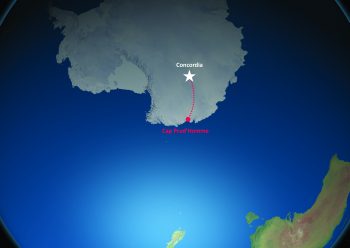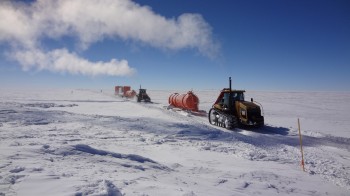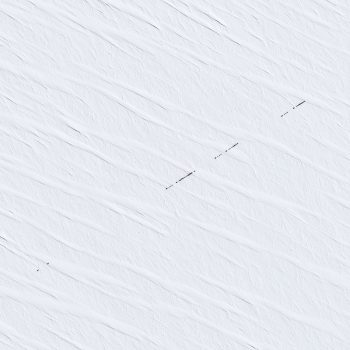Didier Schmitt is a member of the space Task Force at the European External Action Service. He is a regular opinion writer in major newspapers and magazines and has published a book on foresight. He will be contributing to this blog during his visit to Concordia – after arriving by helicopter he took part in a supply run to Concordia:
While you enjoyed a well-deserved holiday period with your families much has been going on this side of the world. I was quickly transferred from the Antarctic Dumont D’Urville station (which is located on an island in fact) to the continental French-Italian base Prud’homme. It is a large station where tractors and snow groomers are prepared and repaired between the long traverses across the continent called ‘raids’. As the Astrolabe ship was stuck in the ice, large supply items could not be unloaded so we will be the smallest Raid ever… we will still be transporting 300 tonnes in a 300-m long convoy.
On Christmas day we were ready. A helicopter with VIPs came to great us: quick group photo and off we went. It is a little like an astronaut crew launch. There are two Italians and four French. Previous Raids included Australians and Koreans.
No passengers are allowed. Every person is in charge of a vehicle. I only had a few hours for a test-drive the day before… While Father Christmas delivers gifts with reindeers we do it with mammoth-tractors weighing 22 tonnes.
During the first snow storm I felt what it is to work in such extreme conditions. It can get much nastier in November and February: –55°C and 130 km/h winds with no visibility. Working in these circumstances is worse than doing a spacewalk. Everyone knows what he has to do and there is redundancy in qualifications like on the International Space Station.
A few days in we unload kerosene on a snow airfield – like a Lagrange point between Prud’homme and Concordia. During the previous Raid, the Pleiades satellites took nice pictures of the convoy. The whole trail has been mapped with these satellites.
It is such a great experience, but very challenging as everything is new and you can feel that it is a risky undertaking. On day four we already reached 2000 m altitude which is the average ice sheet thickness of the continent. We are in the middle of nowhere with 24 hour sunlight and a sky that has very unusual features.
On day eight we reached 3100 m. Because the air is much thinner here than on the equator the oxygen levels are equivalent to being 3800 m high in the Alps. The landscape is breath-taking, as is the landscape… This is one of the reasons we had to pass a medical selection.
I am eager to discover the Concordia “ice village” at the end of this slow-motion Mad Max adventure…







Discussion: no comments